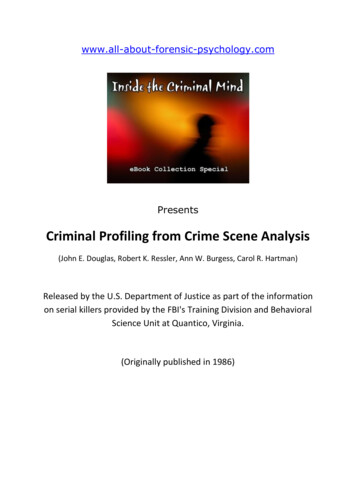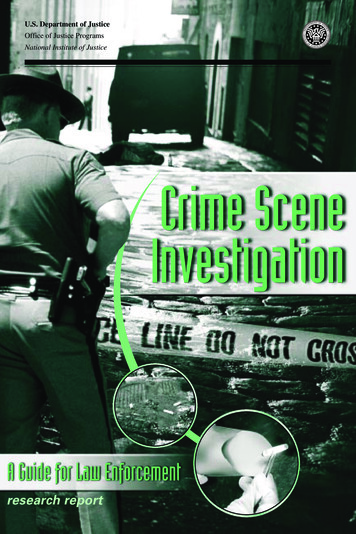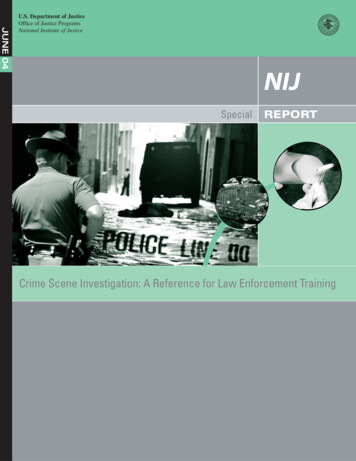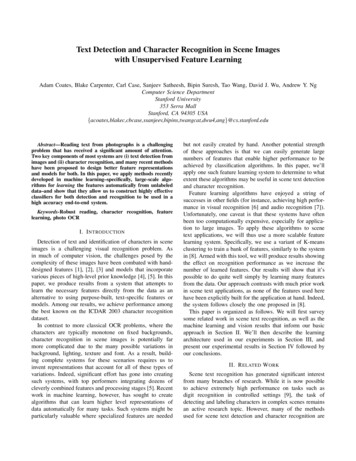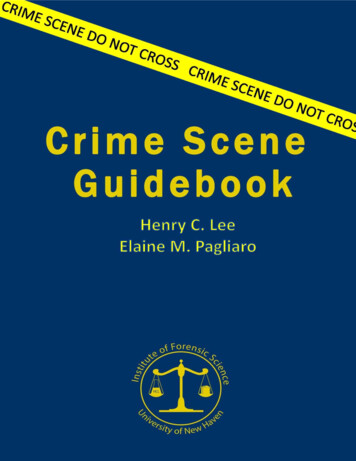
Transcription
CRIMESCENE GUIDEBOOKHenry C. Lee Institute of Forensic ScienceHenry C. Lee, Ph.D.Elaine M. Pagliaro, M.S., J.D.Timothy Palmbach, M.S., J.D.Joseph Sudol, M.S.Stephen Shiner, M.S.Tianyin Lu, M.S.Lu, Jiaqi, M. S.Effie Chang, M.D.This project was support by Grant No. 2009-D1-BX-K031 awardedby the Bureau of Justice Assistance. The Bureau of Justice Assistance is a component ofthe Office of Justice Programs, which also includes the Bureau of Justice Statistics, theNational Institute of Justice, the Office of Juvenile Justice and Delinquency PreventionThe SMART Office, and the Office for Victims of Crime.Points of view or opinions in this document are those of the authors and do notrepresent the official position or policies of the United States Department of Justice.
IntroductionThere are approximately 77,000 law enforcement and police agencies in the United States.More than 80 percent of those departments have fewer than 100 officers. The current status ofcrime scene response by law enforcement generally falls into two categories. The FBI, statepolice/department of investigation and large urban police agencies have developed highlysophisticated, extremely effective evidence response teams with extensive resources and largebudgets. These teams respond to numerous scenes of various types where team personneldocument and collect evidence. Most of smaller police agencies cannot afford a large crimescene investigation staff or a mobile crime scene unit to process scenes. Often detectives oreven patrol officers have to carry out the crime scene process. Thus, there is a critical need totrain personnel in small and medium-sized departments to recognize physical evidence, to useboth basic and the newest technologies, and to collect and preserve various types of physicalevidence at the scene-processing stage. This stage usually determines whether theinvestigators will succeed or fail solving the crime. Despite advances in forensic science, manycases remain unsolved or are lost in court due to the failure to identify or preserve evidence orbecause evidence is not properly recognized, enhanced or collected.Alternately, small and medium-sized departments can take advantage of resources that areavailable in their region including major crime squads from federal or state agencies, largercities, local universities with forensic science departments, or forensic centers (such as theHenry Lee Institute of Forensic Science). In addition, a regional team approach has beensuggested and attempted by some jurisdictions. In those regions, each department committedat least one detective to a regional crime scene team; members of the team were trained inadvanced crime scene processing techniques. Those team members responded to all majorcrimes in the area, thus providing skilled, experienced investigators for the whole region. Thismodel can be further enhanced by the addition to the team of the forensic institute with itsadvanced technology and expertise. Such an approach was in practice in Connecticut, wherethe Henry Lee Institute of Forensic Science provided crime scene technology assistance andtraining for the local police officers. That program was supported by a recent grant provided bythe Department of Justice, Bureau of Justice Assistance. (NIJ grant #2010-DD-BX-K024)
This manual is divided into three sections to assist those in detective divisions or crimescene units, especially those from smaller departments, in evaluating crime scenes andassessing what technologies and assistance may be useful in the processes of recognition,identification, documentation of physical evidence and reconstruction of a crime scene:Section I provides an overview of crime scene investigation theory and basic crime sceneprocess.Section II offers information on advanced technologies that are available for use by lawenforcement personnel and forensic scientists; many of these instruments may be available atthe local forensic science laboratories, universities or forensic science programs. Theadvantages of these advanced technologies are briefly described. Any equipment or othermaterials specifically referenced are used for illustrative purposes only and do not serve as anendorsement by the Department of Justice, the National Institute of Justice or the authors.Section III provides a practical guide to resources, including some useful websites,manufacturer information and crime scene references. In some cases, manufacturers mayprovide technical assistance as well as application information. Crime scene investigators andpolice officers can take advantage of the wealth of information and technology available fromthese sources.This project was supported by Grant No. 2009-D1-BX-K031 awarded by the Bureau ofJustice Assistance. The Bureau of Justice Assistance is a component of the Office of JusticePrograms, which also includes the Bureau of Justice Statistics, the National Institute ofJustice, the Office of Juvenile Justice and Delinquency Prevent, the SMART Office and theOffice for Victims of Crime. Points of view or opinions in this document are those of theauthors and do not represent the official position or policies of the United State Departmentof Justice.The authors also would like to thank colleagues at the University of New Haven, PresidentSteven Kaplan, Dean Mario Gaboury of the College of Criminal Justice & Forensic Science, andmembers of the Department of Forensic Science for their support and assistance with thisproject.
CRIME SCENE GUIDEBOOKSECTION I: Crime Scene Investigation
Part 1. OverviewContemporary law enforcement has greatly expanded its ability to solve crimes bythe adoption of advanced forensic techniques and standardized crime sceneprocedures. Today, crimes often can be solved by detailed examination of the crimescene and analysis of forensic evidence and reconstruction of the crime. Knowledge offorensic evidence is not only crucial in investigations and prosecutions of criminal cases,but also vital in civil litigations, major man-made and natural disasters, and theinvestigation of global crimes. In addition to analysis of forensic evidence, thesuccessful solving of cases is based upon a system that emphasizes teamwork,traditional detective work, public support, advanced investigative skills (such as GPSpositioning, cell phone tracking, video image analysis, artificial intelligence, datamining), and the ability to process a crime scene properly by recognizing, collecting andpreserving all relevant physical evidence.If potential physical evidence is not recognized, collected or properly preserved andtested, the forensic value of the physical evidence is forever lost. Numerous day-to-dayand high profile cases have demonstrated the harsh reality that, despite the availabilityof current crime scene technologies, specialized equipment, and a sophisticated forensiclaboratory, the effectiveness in the utilization of physical evidence in crime solving isonly as good as the knowledge and the integrity of the crime scene investigator and theobjective legal system that supports those functions.Scientific Crime Scene InvestigationCurrently, most of the textbooks in the field limit crime scene investigation to thedocumentation of the crime scene and the subsequent collection and packaging of thephysical evidence. The role of the crime scene investigator has unfortunately beenlimited to a crime scene technician who is often only involved in the documentation ofthe crime scene and the collection and preservation of the physical evidence from the
crime scene. Documentation of the crime scene and the collection of the physicalevidence are important aspects of the crime scene investigation and must be properlyperformed. However, these activities are purely routine and mechanical tasks. Whilethe completion of these crime scene tasks is essential in maintaining the integrity of thephysical evidence and providing the final outcome of the criminal investigation, anyinvestigator with minimal training and good discipline can perform these tasks withmoderate precision. These tasks are extremely important; however they have alimited direct value on the solution of the crime.Scientific crime scene investigation is a process which not only includes the aboveaspects of crime scene documentation and physical evidence collection, but alsodemands and expects more dynamic approaches such as scene survey, scene analysis,development in the links among the physical evidence, the scene and persons, and thereconstruction of the crime scene.Crime scene investigation is based on scientific reasoning. That means that theinvestigation of the crime scene involves a systematic, methodical and logical approach.It begins with the initial response to a crime scene, and continues through the scenesecurity, the crime scene documentation, recognition of the physical evidence, thephysical evidence processing, the physical evidence collection, packaging andpreservation, the physical evidence examination, the crime scene analysis and profile,and ultimately concludes at the crime scene reconstruction. Furthermore, systematiccrime scene investigation is based on the principles of the Locard Transfer Theory aswell as the Linkage Principle. The utilization of scientific knowledge in conjunction withthe forensic techniques of physical evidence examination will generate investigativeleads, and, thus, ultimately solve the crime.Physical evidence obtained from the crime scene or other segments of theinvestigation is often the cornerstone upon which the successful outcome of the case isbased. Yet, many cases are never solved or prosecuted due to the lack of physicalevidence. On the other hand, some innocent people are arrested and prosecutedbecause of witness misidentification or the misuse of forensic evidence. While it is
theoretically possible that a near perfect crime can be committed in which theperpetrator was able to leave minimal evidence, it is more likely that the criticalevidence was never recognized and found. Many investigators have obtained thenecessary expertise to document, collect and preserve various types of physicalevidence. However, the presumed simple task of recognizing critical evidence can oftenbe the failure point of the crime scene investigation. The recognition of evidence,enhancement of pattern evidence at a scene, and the proper preservation of thatevidence for further examination are crucial to the success of a case investigation.One common, yet incorrect, practice at a crime scene is to collect everything thatcould be, in any possible manner, construed as evidentiary in nature. This approach isnot only a waste of time and resources, but could potentially cause legal, scientific andinvestigative issues; if every object at a scene is collected and submitted to the forensiclaboratory for further analysis, the forensic facility will be overwhelmed, and it is morelikely that some of the evidence collected will have no probative value. Examination ofmaterials unrelated to the incident can also provide “false leads,” which will wastevaluable resources and may lead to the arrest and even conviction of the wrong person.Conversely, if critical evidence is omitted, altered, or improperly preserved, no modern,state-of-the-art laboratory instrumentation and technology will be able to salvage theinvestigation. Hence, a system must be developed in which the relevant physicalevidence is recognized and located, while superfluous materials are excluded. This willonly result if the crime scene investigators understand the goals of a crime scene search,grasp the concepts and techniques for effective searching, and routinely exercise thediscipline to rely on a systematic, logical, structured search process with a completelyobjective and open mind.Types of Crime ScenesThere are many ways to classify a crime scene:1.The original location at which the crime was committed (e.g. primary scene,secondary scene);2.The type of crime committed (e.g., homicide, sexual assault, robbery);
3.The physical location of the scene (e.g., indoor, outdoor, vehicle);4.The physical condition of the evidence (e.g., buried, underwater);5.The boundaries of the scene (e.g., house, train, bank, computer, car);6.The appearance of the crime scene (e.g., organized or disorganized, passive ordynamic crime scenes);7.The criminal activity at the scene (e.g., active, passive scenes); and8.The size of the crime scene (e.g., universal, macroscopic, microscopic scene).Classification of crime scenes may offer a guide to the investigator on how toproceed with crime scene processing, may suggest types of evidence more likely to befound in the type of case, and may provide a basis for an investigation logic tree.However, classification of the crime scene is sometimes not a clear cut process wheninvestigating a complex situation. Investigators should understand these classificationsystems and how to develop multiple alternate hypotheses. It is important to keep inmind that there is no single classification method that will satisfy all the elements of thecrime scene and its investigation. It is essential that crime scene investigators developthe ability to utilize their analytical skills and logical approaches to make an initialdetermination regarding the number and types of crime scenes that were involved inthe commission of the crime.Once a crime scene has been defined and a “boundary” has been established, thecrime scene(s) should be secured, studied, analyzed, and processed accordingly. Anyactions taken at the crime scene should meet all legal and scientific standards andrequirements.Physical Evidence at the Crime ScenePhysical evidence can be classified according to its physical state, the type of crime,and the nature of the evidence, its composition, or the types of question to be resolved.Each of these classification schemes is useful for offering conceptual ideas and practicalapproaches in crime scene investigation. It is important for a crime scene investigatorto understand the value of physical evidence as well as the limitations of physical
evidence; to appreciate the interaction of various definitions or classifications of crimescenes; to understand the theory of transfer evidence and the possible linkages amongpeople, evidence and the scene; and to understand the proper methodologies forlocating microscopic crime scenes within the more obvious macroscopic crime scenes.It is from the analysis of the crime scene that the crime scene investigator candetermine what type of physical evidence will most likely be found at a particular typeof scene or on a person (suspect, victim, witness), where to find the physical evidence atthe crime scene, and how to recognize, collect, preserve and process the physicalevidence. Finally, based upon scene observations and the laboratory examinationresults of physical evidence, the investigator should be able to analyze and reconstructthe crime scene accurately.We generally perceive relevant forensic evidence to include items such as a weaponused at a homicide, a bullet found in a victim’s body, or a bloodstain pattern. However,in any given case, any particular object may prove to be the crucial piece of physicalevidence necessary to solve the crime. Thus, physical evidence can be best described asany evidence that can provide useful information to investigate the crime.An alternative concept in classification of physical evidence is based upon the natureand form of the evidence: transient, conditional, pattern, transfer, medical, electronic,and associative.1. Transient evidenceTransient evidence is a type of evidence that is, by its very nature, temporary, easilychanged, modified or lost. Commonly encountered transient evidence includes odors,temperatures, color, and some biological and physical phenomenon such as rigidity of abody or the drying of blood. Due to its temporary nature, this type of evidence must bedocumented as soon as the evidence is observed.2. Conditional evidenceConditional evidence is generally produced by a set of actions or inactions. Similarto transient evidence, if conditional evidence is not observed and documentedimmediately at the crime scene, the evidence will be lost forever. Examples of
commonly encountered conditional evidence include: Lighting conditions; smoke or fire;condition of the victim’s body or clothing; window and door positions; whether the TV,radio, computer or other device is on or off; or exact locations of specific evidencewithin the scene.3. Pattern evidenceThere are a variety of patterns that can be found at a crime scene. Most of thesepatterns are in the form of imprints, indentations, striations, or other markings such asfractures or depositions. The patterns commonly found at different crime scenesincludes blood spatter or stain patterns, glass fracture patterns, fire burn patterns,furniture position patterns, projectile trajectory patterns, track-trail patterns, clothing orarticle patterns, tire or skid mark patterns, modus operandi patterns, and gun powder orresidue patterns.4. Transfer evidenceTransfer evidence, sometimes referred to as trace evidence, is generally producedby physical contact between persons, objects, or persons and objects. Some commonlyfound transfer evidence includes blood, fingerprints, hair, fiber, body fluids, soil, glass,drugs and chemicals. This type of evidence is the traditional forensic evidenceexamined in the forensic laboratory.5. Electronic evidenceElectronic and digital devices are potential sources of extensive information in manytypes of investigations. Many residences and businesses have surveillance systems,entry records and alarm information that should be examined during the investigation.Digital and electronic evidence can include video cameras, cellphones, GPS devices,computers, tablets, iPods, tablets, digital cameras, recording devices, telephoneanswering systems and data storage devices.6. Medical evidenceMedical evidence may be used to determine cause and manner of death or injury,medical history, or physical, physiological or mental condition. Medical evidence notonly consists of location, type and degree of injury, but also the condition, number and
size of the wound. Medical history, hospital or clinical records, hospital reports, dateand amount of prescriptions, toxicological analysis, drugs, and medical paraphernaliaare also important in crime scene investigations.8. Associative evidenceDuring the course of an investigation, specific items located at a crime scene may beused as evidence to associate a victim or suspect with a particular scene. It may also beused to associate a victim to a suspect. Examples of associative evidence include: Thesuspect’s vehicle or wallet found at the crime scene; the victim’s ring, watch or otherpersonal belongings found on the suspect; cell phone call records; e-mail messagesrecovered from a suspect’s or victim’s computer; receipts and tickets; business cards;credit or debit card receipts; and other personal papers.Utilization of Crime Scene EvidencePhysical evidence recognition and laboratory analysis can be helpful in directing aninvestigation along a productive path. Not all types of physical evidence will be able todirectly link to or identify a suspect. In fact, the most common use of physical evidencefound at crime scenes is to identify an unknown substance. Examples include theidentification of suspected controlled substances or poisons, identification ofaccelerants in fire debris, blood alcohol levels, and toxicology of blood specimens.Moreover, physical evidence could provide indirect investigative information or leads tothe solution of the crime. This is the most important and significant use of forensicevidence collected from the crime scene.Not every crime scene will have a “smoking-gun” or an eyewitness, but the scenewill definitely contain physical evidence that can help investigating offi
the Henry Lee Institute of Forensic Science provided crime scene technology assistance and training for the local police officers. That program was supported by a recent grant provided by the Department of Justice, B


